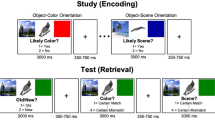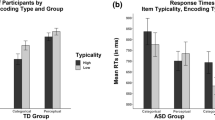Abstract
Diminished episodic memory and diminished use of semantic information to aid recall by individuals with autism spectrum disorder (ASD) are both thought to result from diminished relational binding of elements of complex stimuli. To test this hypothesis, we asked high-functioning adults with ASD and typical comparison participants to study grids in which some cells contained drawings of objects in non-canonical colours. Participants were told at study which features (colour, item, location) would be tested in a later memory test. In a second experiment, participants studied similar grids and were told that they would be tested on object-location or object-colour combinations. Recognition of combinations was significantly diminished in ASD, which survived covarying performance on the Color Trails Test (D’Elia et al. Color trails test. Professional manual. Psychological Assessment Resources, Lutz, 1996), a test of executive difficulties. The findings raise the possibility that medial temporal as well as frontal lobe processes are dysfunctional in ASD.




Similar content being viewed by others
Notes
Although for some individuals observations of difficulties in the domains of communication (N = 4) or Reciprocal Social Interaction (N = 3) did not reach relevant clinical cut-off criteria, sub cut-off difficulties were evident in all individuals. More importantly, all participants had clear statements about their diagnosis by qualified health professionals, and it is widely accepted that ADOS scores must not take precedence over a clinical diagnosis. We thus took the conservative decision not to employ ADOS scores as an exclusion criterion.
Referencess
American Psychiatric Association. (2000). Diagnostic and statistical manual of mental disorders, fourth edition—text revision. Washington, DC: APA.
Bauman, M., & Kemper, T. (1985). Histoanatomic observations of the brain in early infantile autism. Neurology, 35, 866–874.
Boucher, J., Mayes, A., & Bigham, S. (2012). Memory in autistic spectrum disorders. Psychological Bulletin, 138, 458–496.
Bowler, D. (2007). Autism spectrum disorders: Psychological theory and research. Chichester, UK: Wiley.
Bowler, D. M., & Gaigg, S. B. (2008). Memory in ASD: Emerging themes and future prospects. In J. Boucher & D. M. Bowler (Eds.), Memory in autism: Theory and evidence (pp. 330–349). Cambridge: Cambridge University Press.
Bowler, D. M., Gaigg, S. B., & Gardiner, J. M. (2008). Subjective organisation in the free recall of adults with Asperger’s syndrome. Journal of Autism and Developmental Disorders, 38, 104–113.
Bowler, D. M., Gardiner, J. M., & Berthollier, N. (2004). Source memory in Asperger’s syndrome. Journal of Autism and Developmental Disorders, 34, 533–542.
Bowler, D. M., Gardiner, J. M., & Gaigg, S. B. (2007). Factors affecting conscious awareness in the recollective experience of adults with Asperger’s syndrome. Consciousness and Cognition, 16, 124–143.
Bowler, D. M., Gardiner, J. M., & Grice, S. (2000). Episodic memory and remembering in adults with Asperger’s syndrome. Journal of Autism and Developmental Disorders, 30, 305–316.
Bowler, D. M., Matthews, N. J., & Gardiner, J. M. (1997). Asperger’s syndrome and memory: Similarity to autism but not amnesia. Neuropsychologia, 35, 65–70.
Brown, M. W., & Aggleton, J. P. (2001). Recognition memory: What are the roles of the perirhinal cortex and hippocampus? Nature Reviews: Neurosciences, 2, 51–61.
Chalfonte, B., & Johnson, M. (1996). Feature memory and binding in young and older adults. Memory and Cognition, 24, 403–416.
Craik, F. I. M., & Anderson, N. (1999). Applying cognitive research to the problems of ageing. Attention and Performance, 17, 583–615.
D’Elia, L. F., Satz, P., Uchiyana, C. L., & White, T. (1996). Color trails test. Professional manual. Lutz, FL: Psychological Assessment Resources.
Damasio, A. R., & Maurer, M. G. (1978). A neurological model for childhood autism. Archives in Neurology, 35, 777–786.
Gaigg, S. B., Gardiner, J. M., & Bowler, D. M. (2008). Free recall in autism spectrum disorder: the role of relational and item-specific encoding. Neuropsychologia, 46, 993–999.
Happé, F., & Charlton, R. A. (2012). Aging in autism spectrum disorders: A mini-review. Gerontology, 58, 70–78.
Ishihara, S. (1999). Ishihara’s tests for colour deficiency: 38 plates edition. Tokyo, Japan: Kanehara and Co., Ltd.
Leekam, S., & Lopez, B. (2003). Do children with autism fail to process information in context? Journal of Child Psychology and Psychiatry, 44, 285–300.
Lind, S., & Bowler, D. M. (2010). Episodic future thinking in adults with autism. Journal of Abnormal Psychology, 119, 896–905.
Lind, S. E., Williams, D. M., Bowler, D. M., & Peel, A. (2014). Episodic memory and episodic future thinking impairments in high-functioning autism spectrum disorder: An underlying difficulty with scene construction or self-projection? Neuropsychology, 28, 55–67.
Lord, C., Risi, S., Lambrecht, L., Cook, E. H., Leventhal, B. L., DiLavore, P. C., et al. (2000). The autism diagnostic observation schedule-generic: A standard measure of social and communication deficits associated with the spectrum of autism. Journal of Autism and Developmental Disorders, 30(3), 205–223.
Minshew, N. J., & Goldstein, G. (1993). Is autism an amnesic disorder? Evidence from the California verbal learning test. Neuropsychology, 7, 209–216.
Minshew, N. J., & Goldstein, G. (2001). The pattern of intact and impaired memory functions in autism. Journal of Child Psychology and Psychiatry, 42, 1095–1101.
Minshew, N., Goldstein, G., Muenz, L. R., & Payton, J. (1992). Neuropsychological functioning in nonmentally retarded autistic individuals. Journal of Clinical and Experimental Neuropsychology, 14, 749–761.
Mukaetova-Ladinska, E. B., Perry, E., Baron, M., & Povey, C. (2012). Ageing in autism spectrum disorder. International Journal of Geriatric Psychology, 27, 109–118.
Nicolson, R., DeVito, T. J., Vidal, C. N., et al. (2006). Detection and mapping of hippocampal abnormalities in autism. Psychiatry Research: Neuroimaging, 148, 11–21.
Shimamura, A. P. (2010). Hierarchical relational binding in the medial temporal lobe: The strong get stronger. Hippocampus, 20, 1206–1216.
Smith, B. J., Gardiner, J. M., & Bowler, D. M. (2007). Deficits in free recall persist in Asperger’s syndrome despite training in the use of list-appropriate strategies. Journal of Autism and Developmental Disorders, 37, 445–454.
Snodgrass, J. G., & Vanderwart, M. (1980). A standardized set of 260 pictures: Norms for name agreement, familiarity and visual complexity. Journal of Experimental Psychology: Human Learning and Memory, 6, 174–215.
Squire, L. R. (2004). Memory systems and the brain: A brief history and current perspective. Neurobiology of Learning and Memory, 82, 171–177.
Tulving, E. (2001). Episodic memory and common sense: How far apart? Philosophical Transactions of the Royal Society, B, 356, 1505–1515.
Volkmar, F. R., & Klin, A. (2000). Diagnostic issues in Asperger synrome. In A. Klin, F. R. Volkmar, & S. Sparrow (Eds.), Asperger syndrome. New York: Guilford Press.
Williams, D. L., Minshew, N. J., & Goldstein, G. (2008). Memory within a complex information processing model of autism. In J. Boucher & D. M. Bowler (Eds.), Memory in autism: Theory and evidence (pp. 125–142). Cambridge: Cambridge University Press.
Zimmer, H. D., Mecklinger, A., & Lindenberger, U. (2006). Handbook of binding and memory; perspectives from cognitive neuroscience. Oxford: Oxford University Press.
Acknowledgments
The authors would like to thank the participants for giving their time in these experiments, two anonymous reviewers for insightful comments and the Medical Research Council UK for financial support (Grant Number: G0401413).
Conflict of interest
The authors declare that they have no conflict of interest.
Author information
Authors and Affiliations
Corresponding author
Rights and permissions
About this article
Cite this article
Bowler, D.M., Gaigg, S.B. & Gardiner, J.M. Binding of Multiple Features in Memory by High-Functioning Adults with Autism Spectrum Disorder. J Autism Dev Disord 44, 2355–2362 (2014). https://doi.org/10.1007/s10803-014-2105-y
Published:
Issue Date:
DOI: https://doi.org/10.1007/s10803-014-2105-y




